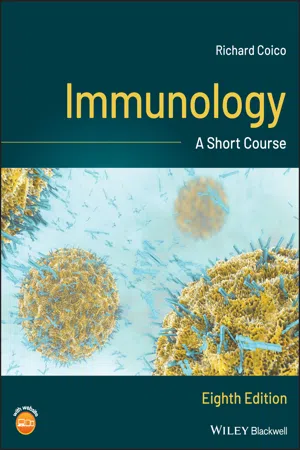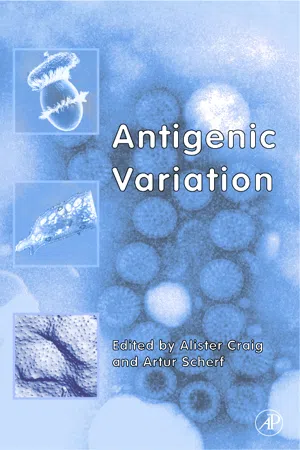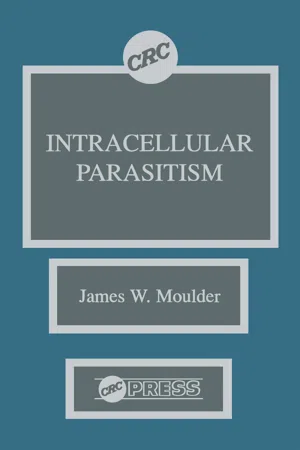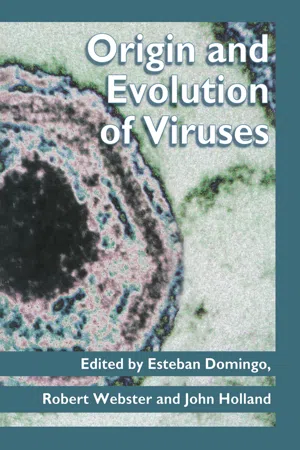Biological Sciences
Antigenic Variation
Antigenic variation refers to the ability of pathogens, such as viruses and bacteria, to alter their surface antigens in order to evade the host's immune response. This process allows the pathogen to avoid recognition by the immune system, leading to recurrent infections and making it challenging to develop effective vaccines or treatments.
Written by Perlego with AI-assistance
Related key terms
1 of 5
8 Key excerpts on "Antigenic Variation"
- eBook - ePub
Immunology
A Short Course
- Richard Coico(Author)
- 2021(Publication Date)
- Wiley-Blackwell(Publisher)
B‐cell superantigens that bind to and alter the expression of certain immunoglobulin gene families have also been described. Antigenic Variation Pathogens can escape the immune system by generating variants with different antigenic composition. This mechanism for evasion of host defenses is known as Antigenic Variation. Classic examples of pathogens that evade the host response by Antigenic Variation are influenza virus, HIV, Streptococcus pneumoniae, trypanosomes, and Group A streptococcus. Each of these pathogens provides an illustrative example of a mechanism for Antigenic Variation. In the case of Group A streptococcus, the M protein is required for virulence and functions by preventing phagocytosis through a mechanism that involves deposition of fibrinogen on the bacterial surface. M proteins elicit protective antibody but are antigenically variable, so that streptococcal infection with one strain does not elicit resistance to other strains. Influenza virus generates Antigenic Variation because it has a segmented RNA genome that can be resorted to yield virions expressing new combinations of the two main surface antigens: the hemagglutinin and neuraminidase surface proteins. Antigenic Variation for influenza virus occurs through both antigenic drift and antigenic shift. Antigenic drift is the result of point mutations in the influenza virus genome; these mutations produce antigenic changes in the hemagglutinin and neuraminidase. Antigenic shift occurs when influenza virus expresses a new allele of hemagglutinin or neuraminidase protein that results in a major antigenic change and the emergence of a new viral strain. The result of antigenic drift and shift for the influenza virus is that the virus changes rapidly, and one influenza infection does not confer protection against subsequent infection - eBook - PDF
- Alister G. Craig, Artur Scherf(Authors)
- 2003(Publication Date)
- Academic Press(Publisher)
Antigenic Variation Copyright © 2003 Elsevier Ltd ISBN: 0–12–194851-X All rights of reproduction in any form reserved 18 T H E I M PAC T O F A N T I G E N I C V A R I AT I O N O N P AT H O G E N P O P U L AT I O N S T R U C T U R E , F I T N E S S A N D D Y N A M I C S N EIL M. F ERGUSON AND A LISON P. G ALVANI Given the ubiquity of antigenic variability in many parasite species, it is perhaps surprising that theoretical analysis of the impact of variation on parasite population biology has been limited until recent years. In part this reflects the Western public health priority in the post-war years on controlling the classic childhood diseases through mass vaccination, and consequent focus of much theoretical research on those diseases as archetypes of all infectious agents. The breakthroughs in our understanding of the molecular basis of vertebrate immunity and disease pathogenesis in recent decades have been key to challenging this view – and have revealed the antigenic stability of diseases such as measles, mumps and rubella to be very much the exception rather than the rule. Indeed, the volume of sequence, immunological and epidemiological data now being generated is outpacing our ability to develop the new theoretical tools necessary for a rigorous analysis of its implications for our understanding of disease population biology. Mathematical studies of Antigenic Variation are thus still largely focused on using simple models to explore the impact of diversity on pathogen fitness, transmission and evolution – with the correspondence between models and data typically remaining qualitative or conceptual rather than statistically rigorous. This chapter therefore provides an introduction into the conceptual insights gained from this recent work, whilst highlighting the many research challenges remaining, particularly in relation to improving model realism. Additionally, some new results examining the relationship between rate of variation and - eBook - ePub
- James W. Moulder(Author)
- 2020(Publication Date)
- CRC Press(Publisher)
T. brucei has a surface coat composed of a variable surface glycoprotein (VSG) which is periodically shed and replaced with an antigenically distinct protein.2 During systemic infection, a change in VSG coat heralds a new wave of parasitemia. The change in VSG follows antibody production specific for a particula VSG, thus the appearance of a new variant promotes persistence of the infection.3 Another example is the bacterial spirochete Borrelia recurrentis that causes relapsing fever. A febrile episode occurs during bacteremia which dissipates following the onset of the immune response and clearance of most of the organisms. An antigenic variant then appears, thus causing a new round of bacteremia and host response.4In both trypanosomes5 ,6and Borrelia,7 the molecular basis of Antigenic Variation arises from a repertoire of unique surface protein genes which are sequentially turned on and off at the transcriptional level. Other examples of Antigenic Variation can be found in the variant pilus antigen of Neisseria gonorrhoeae and Moraxella,8 and the surface antigens of influenza viruses.9 Antigenic Variation for influenza viruses, however, is mediated by gene mutation rather than the genome containing multiple gene homologs. Thus, examples of Antigenic Variation represent a spectrum of molecular mechanisms and variant capacities. Nevertheless, one result of these strategies is the evasion of host immune mechanisms. These adaptations appear to promote parasite survival and persistence in the individual or in the population.Chlamydia trachomatis is a bacterial parasite of humans that only grows within eukaryotic cells, and has an extracellular developmental phase that initiates new rounds of infection.10 This organism is the cause of a wide spectrum of human diseases including trachoma, the leading cause of preventable blindness, and genital tract diseases that often result in sterility of adults as well as eye and respiratory infections of newborns. Thus, most chlamydial infections are limited to mucosal surfaces of the eye, genital, and respiratory tracts. Immunopathology caused by repeated infection or persistent infection eventually results in the most severe manifestations of diseases caused by C. trachomatis - eBook - ePub
- Steven A. Frank(Author)
- 2020(Publication Date)
- Princeton University Press(Publisher)
3. Heterogeneity of immune profiles among hosts. The dynamics of immune profiles can be complex because the spread of parasite variants affects the immune structure of the hosts, and the immune structure of the hosts determines the selective pressures on different classes of antigenic variants. Some preliminary theoretical work along these lines has appeared (Gupta et al. 1996; Andreasen et al. 1997; Gupta et al. 1998; Lin et al. 1999). Similar processes of reciprocal coevolution arise when hosts and parasites have multiple genetic determinants that influence the outcome of an attack (Frank 1993, 1994).4. Examples. Measles apparently can vary its dominant surface antigen, hemagglutinin, and limited variation does occur (Griffin 2001). So it is an interesting puzzle why antigenic variants do not to spread. Perhaps the very high R 0 of measles causes the common strain to spread so widely in the host population that no differences occur between hosts in immune memory profiles. Thus, there is no single-step mutational change that allows a variant to spread to some hosts. The only “nearby” susceptible class arises from the influx of naive newborns.Influenza A may not evolve as quickly and vary antigenically as much in birds as it does in humans (Webster et al. 1992). This suggestion is based on very limited evidence and must be confirmed by further study. If the pattern holds, then many plausible explanations exist. For example, the process of host invasion and spread during an infection probably differs in birds and humans, which may influence the role of immunity in clearance and in subsequent protection. Another possibility is that relatively short-lived species such as many birds have a larger class of naive hosts than comparably long-lived humans, reducing the relative pressure for Antigenic Variation in birds.Passage contains an image 10 Genetic Structure of Parasite Populations
Variant alleles may be grouped together to form discrete parasite strains. For example, some parasites may be of type A/B or A'/B' at two distinct epitopes, with intermediates A/B' and A'/B rare or absent. In this chapter, I consider the processes that group together variants.The first section reviews different kinds of genetic structure. The example above describes linkage disequilibrium between antigenic loci, a pattern that may arise from host immune selection disfavoring the intermediate forms. Alternatively, allelic variants across the entire genome may be linked into discrete sets because different parasite lineages do not mix. Spatial isolation or lack of sex and recombination can prevent mixing. - eBook - PDF
- David A. Hopwood, Keith F. Chater(Authors)
- 2012(Publication Date)
- Academic Press(Publisher)
In Chapters 13 and 14, the basis for a remarkable variation in surface properties of pathogenic Neisseria and E. coli strains is described. The organisms apparently go to great lengths to control the quantitative expression of genes for pili and other surface proteins, which IV 265 266 D. A. Hopwood and K. F. Chater are essential for colonization of the host but may be antigenic liabilities after colonization, as well as to ensure variation in the type of protein expressed, by using one of a variety of switching mechanisms. These include recombination between silent and expression gene copies, flip-flop of an invertible promoter-containing DNA segment, and variation in the number of multiple repeats of a few bases leading to frameshifts that allow or prevent expression of a messenger RNA. Evolution of such devices presumably reflects the power of the mammalian immune system to recognize and destroy invading bacteria, and the consequent premium on its evasion by the pathogen. Enterotoxin production by the causal agent of cholera, described in Chapter 15, provides a further example of a highly evolved component of virulence, in this case a toxin beautifully adapted to interact with host cell receptors so as to enter the cells and modify their physiology in the direction of ion and water efflux. Finally, Chapter 16 describes the lengths to which some bacterial pathogens have been forced to go to secure a supply of vital iron and so invade the tissues and fluids of the animal body which are normally kept almost free of available iron and so are difficult niches for bacteria to inhabit. Chapter 13 The Molecular Basis of Antigenic Variation in Pathogenic Neisseria J. R. SAUNDERS I. Introduction 268 II. Diversity and Virulence 268 A. Diversity is Expressed Phenotypically as Phase and Antigenic Variation 268 B. How is Phase Variation of Adaptive Value? 269 C. How is Antigenic Variation of Adaptive Value? 269 D. - eBook - ePub
RNA Genetics
Volume III: Variability of RNA Genomes
- Esteban Domingo(Author)
- 2018(Publication Date)
- CRC Press(Publisher)
Role of Genome Variation in Disease Chapter 7 Antigenic Variation IN INFLUENZA VIRUS HEMAGGLUTININS J. J. Skehel and D. C. Wiley TABLE OF CONTENTS I. Introduction II. Antigenic Shift III. Antigenic Drift References I. INTRODUCTION Antigenic Variation in influenza viruses primarily involves the hemagglutinin (HA) and neuraminidase (NA) glycoproteins of the virus membranes. Proteins enclosed by the membranes are not invariant; they can be distinguished antigenically by their partial reactions with heterologous, type-specific sera and by using monoclonal antibodies. 1, 2 The genes which specify these proteins can also be differentiated by nucleic acid hybridization 3 and their nucleotide sequences have been shown to differ in a limited number of analyses by up to 8%. 4, 5 By comparison, however, the amino acid sequences of the membrane glycoproteins differ more extensively, by up to 80%, and influenza A viruses are placed in subtypes on the basis of the exclusive reactions of their HAs and NAs with subtype-specific sera. 6 There are 13 antigenic subtypes of HA and nine of NA. All 13 HAs have been identified in viruses from avian species, and more restricted ranges have been obtained from horses, swine, and humans. The three subtypes of HA, H 1, H 2, and H 3, detected in humans since the first isolation of influenza viruses from humans in 1933 7 have been most extensively analyzed, and this review of Antigenic Variation in HAs will concentrate on them. The time periods of their prevalence were H 1, 1918 to 1957 and 1977 to the present; H 2 1957 to 1968; and H 3 1968 to the present. II. ANTIGENIC SHIFT The sudden appearance of “Asian” influenza viruses of the H 2 subtype in 1957 and of “Hong Kong” viruses of the H 3 subtype in 1968, and the displacement by them of viruses of the H 1 and H 2 subtypes, respectively, are commonly called antigenic shifts - eBook - ePub
- David A. Baum, Douglas J. Futuyma, Hopi E. Hoekstra, Richard E. Lenski, Allen J. Moore, Catherine L. Peichel, Dolph Schluter, Michael C. Whitlock, David A. Baum, Douglas J. Futuyma, Hopi E. Hoekstra, Richard E. Lenski, Allen J. Moore, Catherine L. Peichel, Dolph Schluter, Michael C. Whitlock(Authors)
- 2013(Publication Date)
- Princeton University Press(Publisher)
In the 1990s, researchers began to use evolutionary phylogenetics to analyze influenza virus A isolates and track how successful lineages of the virus undergo antigenic drift —that is, specific changes in their hemagglutinin proteins that promote escape from human immune surveillance, allowing these strains to dominate subsequent flu seasons. Refinements of this approach are now used to predict which circulating strains are most likely to give rise to the dominant strains in the coming flu season, so that a vaccine against them can be produced and distributed before they become widespread. However, the effort to match the vaccine with the most important flu variants in a given year sometimes fails. These failures are most problematic when a new strain emerges through antigenic shift —that is, when recombination between virus strains generates a variant that escapes the immune system. Important goals of evolutionary medicine include more accurate forecasting of seasonal flu variants and better predictions of the emergence of new flu strains capable of spurring pandemics. The harm that a given pathogen or parasite causes to its host is often called virulence. An important fact is that virulence often differs markedly, even between closely related pathogens. Thus, another goal of evolutionary medicine is to understand how the virulence of a pathogen is shaped by natural selection. If a pathogen relies on direct transmission from an infected host to a susceptible host, then activities of the pathogen that might seem to increase its opportunity for transmission (e.g., greater within-host production of infectious particles) may weaken the current host and thereby actually reduce the probability of successful transmission. An extreme example would be a pathogen that kills its current host so quickly that a new host is not likely to be encountered - eBook - PDF
- Esteban Domingo, Robert G. Webster, John F. Holland(Authors)
- 1999(Publication Date)
- Academic Press(Publisher)
C HA P T E R 14 Antigenic Variation in Influenza Viruses Robert G. Webster INTRODUCTION Influenza is the paradigm of a viral disease in which continued evolution of the virus is of paramount importance for annual epidemics and occasional pandemics of disease in humans. The gene pool of influenza A viruses in aquatic birds provides all the genetic diversity required for the emergence of pandemic influenza virus- es for humans, lower animals and birds. In humans, pigs and horses, influenza A viruses show both antigenic drift and genetic shift. In contrast, there is evidence that avian influenza viruses in the aquatic bird reservoir are in evo- lutionary stasis. The purpose of this chapter is to establish that rapid evolution in influenza A viruses in humans and other mammals has con- tinued since the beginning of recorded medical history and is dependent on periodic introduc- tions of gene segments or entire influenza virus- es into humans from the avian influenza virus gene pool. In aquatic wild birds, influenza virus appears to be fully adapted to its host and caus- es no disease signs. Continuing evolution is most prominent in the surface glycoproteins of influenza viruses but also occurs in each of the eight gene seg- ments of both type A and type B influenza viruses. This variability results from accumula- tion of molecular changes in the eight RNA seg- ments, which can occur by a number of different mechanisms including: (1) point mutations (antigenic drift); (2) gene reassortment (genetic shift); (3) defective-interfering particles; and (4) RNA recombination. Each of these mechanisms may contribute to the evolution of influenza viruses. Mutations, including substitutions, deletions and insertions, are one of the most important mechanisms for producing variation in influen- za viruses. The lack of proofreading among RNA polymerases contributes to replication errors on the order of I in 104 bases (Holland et al., 1982; Steinhauer and Holland, 1987).
Index pages curate the most relevant extracts from our library of academic textbooks. They’ve been created using an in-house natural language model (NLM), each adding context and meaning to key research topics.







